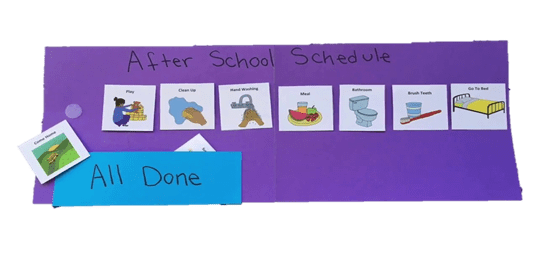Posts Tagged ‘Reinforcement’
 As the spring semester is ending, let’s take a look at what we have discussed. First, we delved into the question of how autism spectrum disorder is diagnosed and what are some of the early signs of autism. A monitoring and screening tool was provided as a resource for parents as well.
As the spring semester is ending, let’s take a look at what we have discussed. First, we delved into the question of how autism spectrum disorder is diagnosed and what are some of the early signs of autism. A monitoring and screening tool was provided as a resource for parents as well.
It might be a tough question when deciding whether treatment is necessary for your child once they are diagnosed. Here are a couple of helpful suggestions to guide your decision-making process. There are many treatment options out there. It could be overwhelming sometimes, we presented applied behavior analysis and other treatment options that are listed by the CDC.
Then, we discussed one of the strategies called planned ignoring. even though it could be an effective intervention, it has to be combined with a reinforcement-based intervention. We also discussed situations in which planned ignoring should not be used. Not only we talked about consequence-based intervention but also, we suggested many antecedent-based strategies to help caregivers be more proactive. For example, using specific instructions, offering choices, and using visual schedules.
Behavior issues are not the only things that parents encounter. Many children have sleep issues. We introduced the bedtime pass and bedtime routines to facilitate better sleep habits for both children and adults.
Remember to visit and like our Facebook page for the latest update on ABA Husky Clinic and future blog posts.
 We discussed how we could present a bedtime pass to your child if they tend to get out of bed and leave their room at night. However, what if it is extremely difficult to put them to bed in the first place? Here are some of the helpful strategies that would help to make that transition easier for bedtime routines The key to a sleep routine is finding a bedtime for the family and your child and stick to it. Thus, the bedtime needs to be realistic, so it is easier to keep it consistent.
We discussed how we could present a bedtime pass to your child if they tend to get out of bed and leave their room at night. However, what if it is extremely difficult to put them to bed in the first place? Here are some of the helpful strategies that would help to make that transition easier for bedtime routines The key to a sleep routine is finding a bedtime for the family and your child and stick to it. Thus, the bedtime needs to be realistic, so it is easier to keep it consistent.
There are many ways to set up a bedtime. One of the methods is to count how long would take your child to get ready in the morning and the hours of sleep your child needs then take the block of time to determine when your child needs to go to bed at night. Children need more hours of sleep than adults as they develop. The common bedtime for children is 8 pm to 9:30 pm. However, as we mentioned if your children need extra time to get ready in the morning, their bedtime might need to be earlier.
Routines for bedtime also pertain to other activities before bedtime. It is useful to establish time blocks for all the activities before bedtime. The order can be adjusted base on personal preferences and needs. For example, the dinner time block can be 5 pm-6 pm, the bath time block can be 8-8:30 pm, and the free time block is 6:30-7 pm. It will be helpful to ensure that calming activities are placed closer to bedtime to facilitate better sleep. The goal is to make the schedule more flexible and customizable. With designated time blocks for activities, sticking to bedtime routines will be easier.
When planning the routine, you can use a 15 minutes time block before bed for you and your child to use the bathroom and say goodnight, and do anything they need (e.g., use the bedroom). If your child has trouble with staying in their bed throughout the night, a strategy called bedtime pass could be helpful. Here is a nice sleep diary for your use. Sleep well!
 So far, we have discussed many behavioral-based strategies that you can use at home and in other settings. For example, behavior-specific praise, shaping, and token economy. These strategies are helpful when you are with your child. However, what if your child is at school and the teacher reports that the child displays unwanted behavior such as disrupting in class, problems with transitions from one task to another? What can you do when you are not around? Teachers are usually extremely busy and have many children in one class to monitor and many lessons to plan. Thus, it is recommended not to rely on the teachers solely. Home-based reinforcement program (HBRP) could be beneficial.
So far, we have discussed many behavioral-based strategies that you can use at home and in other settings. For example, behavior-specific praise, shaping, and token economy. These strategies are helpful when you are with your child. However, what if your child is at school and the teacher reports that the child displays unwanted behavior such as disrupting in class, problems with transitions from one task to another? What can you do when you are not around? Teachers are usually extremely busy and have many children in one class to monitor and many lessons to plan. Thus, it is recommended not to rely on the teachers solely. Home-based reinforcement program (HBRP) could be beneficial.
HBRP is a method for effective behavior change in which your child’s behavior in school is reported to his or her parents who then reward the behavior. Here are the steps for an HBRP:
Be specific with the behavior: What is the behavior that the teacher and you are concern about in school? When defining the behavior make sure to be specific and both you and the teacher have the same definition in terms of what the behavior might look like.
Creating a system: There should be a system set up for the teacher to use when measuring your child’s behavior. Such as a Likert scale of 0 to 2. 0 means there is no change and unwanted behavior is still there and 2 means there is a drastic change in behavior and great improvement is observed by the teacher. At the end of the day, an index card with a point will be handed to you indicating how many points your child earned on that day.
Reward program or token economy: In a separate blog post we discussed the token economy. Similarly, your child earns the points based on the points that she received on that day in exchange for the predetermined rewards. Also, make sure there are various small and big rewards so your child can get smaller rewards immediately or save up tokens for bigger rewards.
To ensure that HBRP will be successful in changing unwanted behavior.
- Working with the teacher to focus on one behavior at a time.
- Your reactions to your child’s score are important to the success of the program.
- Make sure to celebrate small improvement, one of the pitfalls for the program is demanding perfection.
- When score is
- 0 – your response should be calm and do not complain or ask what happened because it might hinder the willingness of the child to participate in the program. For example, you can say “You did not get any points today but you can try again tomorrow.”
- 1 – Praise the slight improvement.
- 2 – Praise the perfect score enthusiastically.
HBRP is a useful strategy to address behavior issues in school and other settings. Most teachers are more than willing to participate as it does not demand a lot of effort and also helps change unwanted behavior.
For next week, we will discuss a behavioral strategy used for sleep problems with children called “bedtime pass”.
 Strategies such as planned ignoring and behavior-specific praise are consequence-based interventions. In other words, those strategies come after the behavior has happened. What if we can address the behavior on the front end? This is when Antecedent interventions come into play. Antecedent interventions are designed to change the environment or setting events before a particular behavior occurs to increase the likelihood of positive behavior. Board-certified behavior analysts (BCBAs) often manipulate antecedents to set up opportunities to prompt more positive behavior.
Strategies such as planned ignoring and behavior-specific praise are consequence-based interventions. In other words, those strategies come after the behavior has happened. What if we can address the behavior on the front end? This is when Antecedent interventions come into play. Antecedent interventions are designed to change the environment or setting events before a particular behavior occurs to increase the likelihood of positive behavior. Board-certified behavior analysts (BCBAs) often manipulate antecedents to set up opportunities to prompt more positive behavior.
There are many common types of antecedent strategies:
Using clear and specific instructions: It is important to keep in mind that when you ask your child to do something, be as specific as you can. For example, instead of saying “Go clean up your room.”, “Pick up 3 pieces of clothing on your bedroom floor.” Having clear and specific instructions is not only easier for your child to comply but also your child knows what is being expected. Of course, you do not need to always be so specific with your instructions, but it is helpful when you start developing positive behavior.
Visuals: Research has shown that individuals who are diagnosed with autism spectrum disorder tend to process visual cues better than auditory ones. Using visual schedules to present clear expectations. They are similar to planners we use for school or work but instead of listing all the tasks for the day.

Offer choices: Giving choices is a powerful tool to increase compliance. Using clear and specific instructions might be enough for your child. However, if you have any problems with compliance, by adding choice, you will increase the impact. For example, you could say to your child “Please put on your green gloves or brown gloves, we are going outside.” By offering a choice, it will greatly increase the chance that your child puts something on right away.
The three antecedent strategies mentioned above are helpful tools to increase compliance and decrease unwanted behavior. It is more effective if you combine them with reinforcement strategies (e.g., behavior-specific praise, token economy).
Next week, we will discuss an effective tool: Home-based reinforcement program (HBRP) to manage your child’s behavior in school settings.

quicktips.com
The applied behavior analysis program at Saint Cloud State University is one of the award-winning programs mention in the Redefining St. Cloud State University campaign. Our Applied Behavior Analysis (ABA) is the only program of its kind in Minnesota. Our students are part of a top-ranked program that educates practitioners to help children who are diagnosed with autistic spectrum disorder. Our graduates are skilled professionals with expertise in a field of high demand with big impacts on children and their families. Learning is fostered by faculty who are nationally regarded for their teaching and research in the field of applied behavioral sciences.
The program prepares students to save families; “We are saving families when they receive services,” said Dr. Witts. Rigorous work is needed to succeed in the program. Dr. Witts said, “ I want students who are okay with tough programs that will help push them farther than they would push themselves, who understand that their work carries great responsibility; that they understand they will have a tremendous effect on the children they will work with and the future of their families.”
The ABA program has been ranked as the number one academic program in the world. For the growing number of families with children who are diagnosed with autism spectrum disorder. The ABA program has been preparing students to provide services to families all over the world.

Drink-tokens
Token economy systems are widely used as a part of applied behavior analysis interventions in different settings such as schools, homes, and clinics. The token economy is a method of delivering tokens for positive behavior to increase the frequency of the desired behaviors (e.g., instructions). Later, the tokens can be exchanged for rewards (e.g. treats, time of iPad, social interaction). You might think “well, I am bribing my child to behave.” To that, a board-certified behavior analyst (BCBA) might tell you “token economy is not bribing.” Remember the differences between reinforcement and bribery! Think of it as how you get paid for working. You would not call that bribery, would you?
When using a token economy, here are the necessary steps:
- Select a behavior: If your child has not experienced a token economy, a BCBA might recommend you choose one appropriate behavior initially. This ensures you can provide the token for that specific behavior. For example, using the word “please” when asking for something, going to bed on time, or doing 10 minutes of math homework.
- Choose rewards: Make sure to choose something that your child enjoys. These items can include their favorite, special snacks, activities, toys, or privileges like staying up late or having a pizza night. Of course, you can also ask your child to give you ideas!
- Select tokens: You can use checkmarks, poker chips, smiley faces, or cartoon characters that your child likes. You can find printouts here.
- Track the earned tokens: You could use a chart or a box and place it somewhere you and your child can see and track points easily.
- Determine how many tokens need to be earned: For different rewards, your child needs to earn a varied amount of token to exchange for them. (e.g. one token for a piece of candy, ten tokens for playing 30 minutes of video games). Also, make sure there are various small and big rewards so you child and get smaller rewards immediately or save up tokens for bigger rewards.
Here are some useful tips on running a token economy program:
- Make sure to provide a token along with behavior-specific praise immediately after the selected behavior.
- Start small and easy at the beginning of the program. You could even start by giving one free token to get the program going each day.
- Change up the rewards from time to time so your child will not lose interest.
- Have your child engages in the token economy development and creation. Your child can design the tokens, or what rewards to earn.
We will introduce another graduate senior behavior clinician at the ABA Husky Clinic next week and learn about how he discovers his love for ABA. To explore more ABA related topics and resources, check out our Facebook page.

entrepreneur.com
First, what is shaping you might ask? Shaping is an invaluable technique used in applied behavior analysis (ABA) to reinforce small steps that eventually lead to the desired skills such as verbal skills, imitation, and independent play. It is especially helpful for children diagnosed with autism spectrum disorder (ASD). Shaping breaks down tasks into smaller pieces that are easier for the child to manage and master the skills.
Shaping allows parents to celebrate small steps and through these positive approaches to change behavior. Even though the process of learning a skill will be typically slower with shaping technique. However, for many children, it has been quite successful.
There are a few steps when practicing shaping:
- Identify a task you want the child to learn.
- Select something the child enjoys playing with, eating, or providing attention.
- Breaking the task down into small steps.
- Once the child performs the small step, make sure to provide the reinforcer and special praise (behavior-specific praise)
- After a couple times of successes, increase requirements gradually. In other words, adding the next small step.
Let us apply those steps with an example of sitting at the dinner table for 10 minutes.
- You would like the child to sit at the dinner table for 10 minutes. (identify a task)
- The child really likes goldfish crackers, so you decide to use them as a reinforcer. (select a reinforcer)
- You know sitting at the table for 10 minutes is way too difficult for your child. You decide you would start with 30 seconds. (breaking down the task)
- After you see your child sitting at the dinner table for 30 seconds you immediately provide a goldfish cracker and say “Mei, you did a great job sitting at the table” with a gentle pat on the shoulder. (provide selected reinforcer and behavior-specific praise)
- Now the child can sit at the dinner table for 30 seconds a couple times. You decide to make it one minute next time. (increase the small requirement)
Parents might ask “what if the child does not do the very first step?” A board-certified behavior analyst (BCBA) will tell you to make the first step even easier and smaller. Also, you can always help the child when the first step is too difficult.
For more ABA-related topics and parenting skills in the coming weeks, check out our blog and Facebook page. For more resources on ABA, click here.

blogs.city.ac.uk
In Week 3, we discussed the topic of behavior-specific praise. This week we are going to incorporate the strategy with the new technique: praising the alternative behavior. Sometimes, parents want to simply change or get rid of behaviors that the child engages in. For example, arguing with siblings constantly, throwing a temper tantrum when told no, or not following instructions. When thinking of trying to stop a behavior, naturally we are more inclined to punish it. However, a board-certified behavior analyst (BCBA) will tell you to praise or reinforce alternative behavior instead.
Praising the alternative behavior is not as easy as it might sound. Simply recall the last time you praise your child when she was sitting quietly watching TV or playing nicely with siblings. You might ignore this until you are hearing them arguing then you might be inclined to yell at your child or even tell them to stop doing that. A phenomenon called negativity bias in which we have this natural instinct that forces us to notice more what is wrong in our environment because it has survival values. It makes noticing appropriate behaviors even more challenging.
To apply the technique of praising alternative behavior:
- caregivers will need to find the behavior that they do not want first.
- Next, find the positive behavior that can replace the behavior or identify what the opposite of the problem behavior is.
- Now, it is time to catch the child in the “act” or being good.
- As the child displays the positive behavior the caregivers want, behavior-specific praise will be provided.
For example, if you are trying to get rid of the behavior of the child arguing with the siblings (selecting the behavior you want to change). You would find times that the child is playing with siblings nicely ( the opposite of the problem behavior) and you could say “ Josh, it is so wonderful to see that you are playing with your sister so nicely” and give the child a gentle hug (delivering behavior-specific praise).
You might think why not just go ahead and punish the behavior? In applied behavior analysis (ABA), Punishment is always the last resort. Also, in this case, if you use punishment procedures, you only stop the problem behavior by using reprimands and not teaching the child what to do instead. Applying the technique of praising the alternative behavior will help the child to know what to do instead and by reinforcing the positive behavior, you will see more of it in the future.
For more information on the power of reinforcement check out this blog post and like our Facebook page for new content in the coming weeks.
 Have you ever witnessed a situation where a parent and child are at the candy aisle, the child starts crying and yells “I want candy, I want candy, you never buy me candy.” The parent yells “no, you are eating too much junk food lately.” The child cries louder and drops to the ground. Shoppers at the supermarket start to pass their judgmental looks. The parent gives up and yells “okay. stop crying, I will buy you the candy.” The child stops crying and receives candy.
Have you ever witnessed a situation where a parent and child are at the candy aisle, the child starts crying and yells “I want candy, I want candy, you never buy me candy.” The parent yells “no, you are eating too much junk food lately.” The child cries louder and drops to the ground. Shoppers at the supermarket start to pass their judgmental looks. The parent gives up and yells “okay. stop crying, I will buy you the candy.” The child stops crying and receives candy.
Maybe your child’s board-certified behavior analyst (BCBA) has suggested you do something similar to this: before going into the supermarket, then you can tell the child “ if you will not cry or yell the whole time when we are in there, I will buy you candy after we are done shopping” The child behaves. The parent praises the child for what a wonderful job they have done and buys the child candy.
As a parent or someone new to applied behavior analysis (ABA) you might think, I am constantly bribing my kid! There has to be a better way. As a parent or caregiver of chilren diagnosed with autism spectrum disorder (ASD), you might think positive reinforcement and bribery are the same because they both offer rewards to a child. It is important to know the difference between reinforcement and bribery because bribery tends to lead to more disruptive behaviors and reinforcement will help parents to see more desired behaviors.
Let us look at the definitions for reinforcement and bribery:
Reinforcement: The action of strengthening or encouraging a pattern of behavior typically by reward or encouragement.
Bribery: The offering, giving, receiving, or soliciting of any item of value to influence the actions.
Timing is what distinguishes reinforcement from bribery. For example, together a BCBA and parent plan out a reinforcement plan before disruptive behavior happens. Parents may state the rule to the child, “Remember if you [blank], you can earn [blank]. However, bribery is reactive and often you might resort to this when challenging behaviors occur at the moment and sometimes a situation feels out of control.
As you can see, bribery usually happens during behavior in order to get a behavior to stop at that moment. It seems to work in the situation. It is a short-term effect, and unavoidably, it will not decrease challenging behaviors. The above example illustrates, reinforcement should be planned, and reinforcer should be delivered following the desired behavior. Therefore, desire behaviors will occur more often in the future.
I hope after reading this, you have a better understanding of the difference between reinforcement and bribery. Timing is the key. Reinforcement is proactive and planned out by the caregivers while bribery tends to be reactive.
Next week, we will discuss the type of praise that will change behavior since they are not all created equal! Be sure to keep an eye out for the newest blog post next Friday! Please like us and share our posts on Facebook. You can also explore our blog for more ABA related information.

via welcomebabyuc.blogspot.com
Yes! Our weekly posts are back, and we plan to have a new post every Friday for the next ten weeks! This semester we will be focusing on how professionals (board-certified behavior analysts; BCBAs) in applied behavior analysis (ABA) use reinforcers and implement reinforcement-based interventions. We will review the type of praise that will change behavior, how to respond to “Nos” and the concerns of giving too much praise, and other tips, suggestions, and recommendations! If you are a parent with a child or at risk for Autism or behavioral challenges, these strategies will certainly come in handy when interacting with your child.
In our weekly posts, we also want to keep you updated on what is happening at the Husky ABA Clinic. This semester we are providing telehealth services to local families impacted by autism. If your family or someone you know could benefit from behavioral services, please contact Odessa Luna, Ph.D., BCBA-D (P: (320)308-4167|E: odluna@stcloudstate.edu) We will also introduce our incredible, new junior and senior graduate clinicians working in the Husky ABA Clinic.
Next week, we will begin our reinforcement series by discussing reinforcers and bribery. You may think providing reinforcers means you are bribing your child. Spoiler alert! This may not be what is happening! In our next post, we will define and discuss the differences between reinforcers and bribery. You do not want to miss what is coming up!
If you would like to know the topics for the coming weeks, please like us on Facebook. You can also explore our blog.
 As the spring semester is ending, let’s take a look at what we have discussed. First, we delved into the question of how autism spectrum disorder is diagnosed and what are some of the early signs of autism. A monitoring and screening tool was provided as a resource for parents as well.
As the spring semester is ending, let’s take a look at what we have discussed. First, we delved into the question of how autism spectrum disorder is diagnosed and what are some of the early signs of autism. A monitoring and screening tool was provided as a resource for parents as well.









